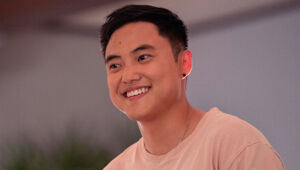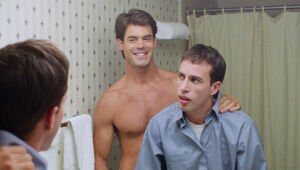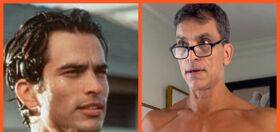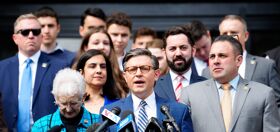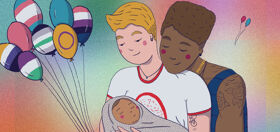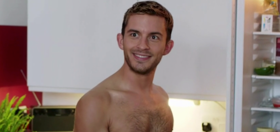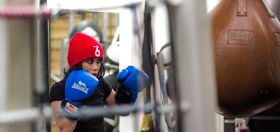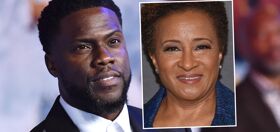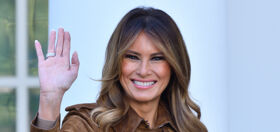
Currently celebrated with the “Queer Maximalism x Machine Dazzle” exhibit at New York’s MAD (the Museum of Arts and Design), Pennsylvania-born Machine Dazzle has long specialized in uniquely flamboyant, eye-popping — and, at times — political ensembles for artists like the Dazzle Dancers (a ’90s performance group of semi-clad strippers/variety show-style entertainers) and Taylor Mac (the successfully subversive Off-Broadway playwright/performer). The 50-year-old designer, born Matthew Flower, put down his BeDazzler for a second to tell Queerty how activism has infused his designs.
Hi, Machine. So you adore things that are homemade and handmade, correct?
Definitely. I love the sense of the hand. I don’t make products that are for sale; I create moments. I love unique, one-of-a-kind things. I love when people do things themselves. People tell me I inspire them to make things, and that’s great. The creative spirit, the creative hand… as soon as you bring money into it, sometimes it ruins the situation. Going to a store, it’s sometimes where people go to die. The bad lighting and the salesperson… it’s a very rigged and forced situation. The creative mind is a revolution.
Were you designing when you came to NYC in the summer of ’94?
How about we take this to the next level?
Our newsletter is like a refreshing cocktail (or mocktail) of LGBTQ+ entertainment and pop culture, served up with a side of eye-candy.
No. I was in school and bought a one-way ticket to NYC. I was artistic, but it wasn’t until I moved to New York that I started making things — on myself, my own body. It was experimental drag, genderf*ck drag before other people were doing it. I didn’t wear boobs. I didn’t tuck. I loved my own body. That wasn’t new — The Cockettes did it long before me — but it wasn’t the common thing for drag, if you even call it drag.
And you’d wear your costumes out to clubs?
Yes — to Dean Johnson’s HomoCorps [a queer rock party], Squeezebox [a mixed rock night], and Jackie 60 [a cutting-edge nightclub]. There was always a theme at Jackie 60. And they still produce Night of 1000 Stevies [an annual tribute to Stevie Nicks].

The ultimate theme party! In the ‘90s, AIDS was still a huge issue in the queer community, and activism had become prevalent. And after that, we all marched against George W. Bush and the war in Iraq. Did all of that focused rage affect your fashion?
It did. I found myself wanting to use special colors. I feel like I’m still deconstructing the “Old Glory” — the American flag — ripping it up and recreating it. It took me a while to realize flags don’t represent everybody. Why do we have so many f*cking flags? Why even have flags? I’d use the red, white and blue, but I’d usually replace blue with black, which made it like Butoh, a post-modern dance form after Hiroshima and Nagasaki, which is interesting to me. For a show by the dancer Stanley Love, I did a vintage American flag, shredded and wrapped around the neck as a collar. I loved the 1960s when they were making all these buttons. “Peace, Not War.” You saw that again in the ‘80s — the button look. It’s almost like wearing bumper stickers.
Did any alleged “patriot” ever confront you for shredding the flag?
Yes, in 2018. I was in Portland, Maine, with Taylor Mac. We did a show, and I had a residency. I had gone up two weeks prior to work with students. They had given me a studio space, which was basically a storefront, so people could see me creating. This veteran was walking by the window, and I was shredding this old American flag. He came in, and he was “This is wrong,” and blah blah blah. I was trying to tell him I’m actually patriotic; we’re just seeing it differently. “I’m celebrating diversity, and you’re celebrating a homogenized way of thinking.” He said he was gonna report me. Of course, nothing happened. And I turned that into an outfit for Taylor Mac!
And, of course, part of being patriotic is using freedom of expression to do what you were doing.
Yes.

What other factors helped your signature looks evolve?
I couldn’t afford to buy things, so I was finding things and making things. I went to Lee’s Mardis Gras [a New York City boutique popularized by trans and drag customers]. This was before the Internet. I would go to used clothing stores and get old dresses, anything that fit — of course, I was much thinner back then. I would alter them, change them. I was doing wigs, but I realized how common wigs are — every drag queen wears a wig. I wanted something that took the place of hair, like a crown, a headdress that was simulated hair but wasn’t hair. That set me apart from the drag community. One time, when I was working the door at the Slide [a sexy East Village gay bar] in the early aughts, one old-school queen thought I was a mockery of drag. Some queens thought I was making fun of drag. I wasn’t; I was just experimenting with my own style. I wasn’t doing the proper makeup and the breast and hips.
Back in the ‘90s, I was experimenting with myself, finding myself. It wasn’t until 2001 that I started working with the Dazzle Dancers. After 9/11, I got more political, and the activist really came out. I would go to protests and marches in Washington, DC. I was in a group called Glamericans — glamorous Americans for peace.

I was in drag with a real message then. To me, a protest sign became a drag accessory. We were protesting George W. Bush in general and definitely Iraq. In 2003, I was protesting the Carlyle Group [an investment firm], and that’s when I met [drag performer/historian] Linda Simpson. These business groups make money off war. And the money went right back into Dubya’s pockets. We were in drag, pretending to be Texas oil billionaires. I had a mink stole and a cowgirl hat. My slogan was “Baby, I am the bomb.” Well, 52 of us got arrested. I always tell people, “If you have to get arrested, get arrested in drag.” They don’t put you with everyone else. They put me and Linda in the women’s section of the jail. We all got a settlement five years later for getting our First Amendment rights taken away from us. You kill people, you have to let us at least complain about it!
Right on! When did your association with Taylor Mac start?
The early 2000s. I was a Dazzle Dancer then, performing in clubs, and Taylor was around, gluing stuff to his face and playing the ukulele. Taylor asked me, “You want to be part of this alien fashion show to raise awareness for immigration?” at HERE performing arts center. This was 2002. I did it, and it was fun and also activism as costume, and I was playing on the word “alien” and having Martians. One day, Taylor asked me to make them a lily costume. After a few years, that became their play, The Lily’s Revenge. I was the costume designer, and I also made an appearance in it. That started our big-time association.
In 2010, we did The Walk Across America For Mother Earth at La MaMa, then we started working on A 24-Decade History of Popular Music. Not all at once. Taylor would say, “Can you make me a 1970s-inspired outfit?” Then they came back to me and said, “Can you make me a 1930s outfit?” Then they called a meeting and said, “Here’s what we’re doing — 24 different decades.” It turned into 24 hours in a row. In 2016, we were heavily workshopping everything and started traveling to workshop these decades. I was able to quit my day job as a jewelry designer.

But of course, your period costumes were not about replicating but interpreting.
Correct. I don’t do period costumes, I do period costumes my way. Taylor needed something to wear while they workshopped these songs. It wasn’t until they announced the whole show that I understood what we were doing. We were workshopping it for five years.
What did you come up with for the 1970s, for example?
The original outfit, Taylor ended up losing. I gave them one of those granny ponchos with fringe on it, with green and orange and white acrylic. I punched a hole in it and made it a poncho. I gave them pantyhose — there’s something about tan pantyhose from the ’70s that I remember. That’s a childhood thing. And I gave them ‘70s leather boots, but the drag version. And I put a long auburn wig on it.
In addition to theater costumes, do you ever do personal ensembles for clients?
I take private commissions. Right now, it’s whoever asks me. Recently, Diane von Furstenberg said, “I’m, invited to this party in October, and the theme is futurism. I don’t want silver, tin foil, or Star Wars. Mushrooms are the future.” We started talking about that shroud you can buy and after you die, wrap it around, and you turn into a mushroom. [Laughs] I also helped her at the Metropolitan Museum of Art’s “Camp” gala in 2019 when she went as Lady Liberty. I made the accessories. Her team made her dress, which was pink chiffon with Warhol’s portrait of her on it. She went as Lady Liberty because, with her philanthropism, she’s been maintaining the Statue of Liberty, and she opened that museum on Liberty Island.

The day of the gala, Diane’s brother called her and reminded her of what the anniversary was, to the day: It was 75 years since their mother was taken to Auschwitz. Diane went representing freedom and liberty the same day her mother was taken to Auschwitz. It makes it so much more meaningful. That part is not camp. Diane is not camp. She’s earthy and serious. She dresses simply and revolutionized women’s fashion. “Be comfortable, be yourself.” She came up with the wrap dress — the most comfortable dress of all time. Go to her store. The woman is highlighted — not the dress, but the woman herself. She wants the woman to sparkle, not the dress.
I’m glad to hear that not all stores are the devil. What else are you working on?
I’m about to do an opera called Io, an ancient Greek reference, next Spring in DC with Opera Lafayette. It’s modern. And Taylor and I are planning our next show, Bark of Millions. It’s an all-queer show with live musicians and 13 singers. I’m doing the costumes and am part of the ensemble. The show celebrates queer icons from the beginning of time into the future.
As for your own iconography: Your outfits are “too much” in the best sense. But how do you stop them from really being too much?
I am essentially storytelling with my costumes. “Too much” would be a run-on sentence. I like to tell the story, but I also like to tell multiple stories at the same time. For me, “maximalism” is not only visually layered — more is more — it’s conceptually layered — idea on top of idea on top of idea. At one point, you know you’re finished. Usually, it’s when there’s a deadline. “OK, there’s a performance. Time to stop.” But I don’t consider any costume finished. I consider them living sculptures, and I change them at will. A costume I made 20 years ago might still work, but maybe it doesn’t. I’m a different person now, I see things differently, and the world has changed. I always overprepare, so I’m ready for everything. It’s like making dinner. You can’t have too much. You can always take away.

“Queer Maximalism x Machine Dazzle” is on display at New York City’s Museum of Arts and Design through February 19, 2023.



